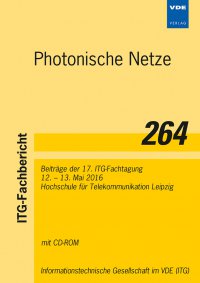Effective Mitigation of Non-linearities Using Extended Kalman Filtering for Dispersion Managed Links
Conference: Photonische Netze - 17. ITG-Fachtagung
05/12/2016 - 05/13/2016 at Leipzig, Deutschland
Proceedings: Photonische Netze
Pages: 5Language: englishTyp: PDF
Personal VDE Members are entitled to a 10% discount on this title
Authors:
Pakala, Lalitha (Institute of Microwaves and Photonics (LHFT), Erlangen Graduate School for Advanced Optical Technologies (SAOT), Fiber Optic Transmission and Sensing (FiTS), University of Erlangen-Nuremberg, Erlangen, Germany & Technische Hochschule Georg Simon Ohm, Nuremberg, Germany)
Schmauss, Bernhard (Institute of Microwaves and Photonics (LHFT), Erlangen Graduate School for Advanced Optical Technologies (SAOT), Fiber Optic Transmission and Sensing (FiTS), University of Erlangen-Nuremberg, Erlangen, Germany)
Abstract:
We investigate our proposed carrier phase and amplitude noise estimation (CPANE) algorithm using extended Kalman filter (EKF) for mitigation of non-linearities as well as ASE induced phase and amplitude distortions, in fully compensated periodic dispersion managed (DM) links employing standard single mode fiber (SSMF) and dispersion compensating fiber (DCF). Numerical simulations were carried out on a 224 Gb/s polarization multiplexed (PM) 16-quadrature amplitude modulation (QAM) coherent transmission system for DM links with varying launch power and transmission distance, in this study. The non-linear mitigation performance of EKF-CPANE is compared to that of conventional single step non-linear (SSNL) compensation. Numerical results show that EKF-CPANE exhibits slightly improved performance compared to SSNL compensation method. We further investigate the combined performance of these two methods by employing EKF-CPANE after SSNL compensation for the mitigation of residual non-linear distortions. As a result, an enhanced tolerance towards non-linearities of up to 2 dB can be obtained. Moreover, the combination of SSNL compensation and EKF-CPANE is quite feasible for real-time implementations since each method requires only few complex multiplications to recover one symbol.


